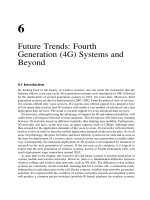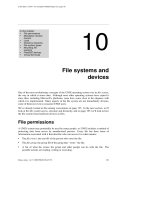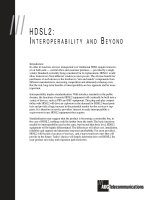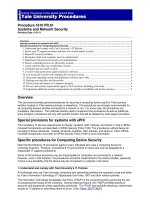Future Trends- Fourth Generation (4G) Systems and Beyond
Bạn đang xem bản rút gọn của tài liệu. Xem và tải ngay bản đầy đủ của tài liệu tại đây (106.48 KB, 14 trang )
6
Future Trends: Fourth
Generation (4G) Systems and
Beyond
6.1 Introduction
By looking back to the history of wireless systems, one can reach the conclusion that the
industry follows a ten-year cycle. First generation systems were introduced in 1981 followed
by the deployment of second generation systems in 1991, ten years later. Moreover, third
generation systems are due for deployment in 2001–2002. From the point of view of services,
1G systems offered only voice services, 2G systems also offered support for a primitive type
of low-speed data services and 3G systems will enable a vast number of advanced voice and
high-speed data services. The trend is towards support for even advanced data services.
3G networks, although having the advantage of support for IP and enhanced mobility, will
suffer from a divergence between several standards. This divergence will limit easy roaming
between 3G networks based on different standards, thus limiting user mobility. Furthermore,
3G networks will have, in the best case, an upper capacity limit of 2 Mbps. Although more
than enough for the application demands of the years to come, 3G networks will most likely
need to evolve in order to meet the mobile application demands of the next decades. As in all
areas of technology, the quest for better and more efficient systems never ends and as soon as
the time for deployment of a system comes, research on the next generation is usually under
way. Consequently, the imminent deployment of 3G systems is accompanied by initiation of
research on the next generation of systems. If the ten-year cycle continues, it is logical to
expect that the next generation of wireless systems, known as Fourth Generation (4G), will
reach deployment stage somewhere around 2010.
As seen later in the chapter, the vision for 4G and future systems is towards unification of
various mobile and wireless networks. However, there is a fundamental difference between
wireless cellular and wireless data networks, such as WLANs. The difference is that cellular
systems are commonly circuit-switched, meaning that for a certain call, a connection estab-
lishment has to take place prior to the call. On the contrary, wireless data networks are packet-
switched. It is expected that the evolution of wireless networks towards an integrated system
will produce a common packet-switched (possibly IP-based) platform for wireless systems,
thus enabling the ‘wireless Internet’. However, in order for such an integration to take place
research is needed in order to provide interoperability between wireless cellular networks and
wireless data networks. The envisioned unified platform for the next generations of wireless
networks will provide transparent integration with the wired networks and enable users to
seamlessly access multimedia contents such as voice, data and video, irrespective of the
access methods of the various wireless networks involved.
The next generations of wireless networks target the market of 2010 and beyond, aiming to
offer increased data rates with reports mentioning from 50 Mbps to 155 Mbps. In the course of
their development many different types of issues (technical, economical, etc.) must be studied
and resolved. Some of them, such as the development of even more efficient modulation
techniques, identification of new spectrum, and developments in battery technology/power
consumption, are quite straightforward and have been identified during 2G and 3G research
and development stages. Other issues are not so clear and are heavily dependent on the
evolution of the telecommunications market and society in general. These issues need to
be identified and resolved at the earliest possible stage in order to unsure market success for
4G and beyond wireless systems.
6.1.2 Scope of the Chapter
This chapter provides a vision of some of the characteristics of 4G and future systems.
Section 6.2 describes the design goals and corresponding research issues for 4G systems.
Section 6.3 presents a preliminary set of possible 4G service classes. Section 6.4 identifies the
challenge of predicting the future of wireless communications and provides three possible
scenarios for the future. Finally, the chapter ends with a brief summary in Section 6.5.
6.2 Design Goals for 4G and Beyond and Related Research Issues
Since 4G systems target the market of 2010 and beyond, there is time for 4G research and
standards development. So far, no 4G standard has been defined and only speculations have
been made regarding the structure and operation of 4G systems. The question to ask here is
what will be the desired advantages and new features of 4G systems over their predecessors.
Due to the fact that related research is under way, 4G is still an acronym without a generally
accepted meaning. However, research efforts [1–3] agree more or less on the following
targets:
†
System interoperability. 4G and future systems should bring something that is missing
from their predecessors: flexible interoperability of the various kinds of existing wireless
networks, such as satellite, cellular wireless, WLAN, PAN and systems for wireless access
to the fixed network. Alternatively, this can be thought of as an ability to roam between
multiple wireless and mobile standards (e.g. moving from a cellular network to a WLAN
while maintaining connections). If the target of system interoperability is met, the whole
worldwide communications infrastructure will be turned into a transparent network allow-
ing users to use it independent of a specific access method. Due to the requirement for
interoperability of different mobile and wireless networks, a big challenge will be how to
access several different mobile and wireless networks through the same terminal. We can
identify the three possible configurations described below [3]:
Wireless Networks190
–
Multimode terminals. This option provides for further development of older generation
systems and has also been applied in the past (e.g. dual AMPS-CDMA cellular phones).
It calls for a single terminal which is capable of accessing several different wireless
networks. This is obviously achieved by incorporating multiple interfaces to the term-
inal, one for the access method of every different kind of wireless network. The ability
to use many access methods will enable users to use a single device to access the 4G
network irrespective of the particular access method used. The option of multimode
terminals will offer increased coverage and reliable wireless access in the case of failure
of one or more networks in an area. Furthermore, the multimode terminal option lowers
the complexity of the fixed part of the network due to the fact that the additional
complexity is incorporated into the device [3].
–
Overlay network. In this architecture users will access the 4G network through the
Access Points (APs) of an overlay network. Upon connection with a terminal, an AP
will select the wireless network to which the terminal will be connected. This choice
will be made based on user-defined choices, resource availability, QoS requirements,
etc. The AP will perform protocol translation and QoS negotiation for the connections.
Since APs can monitor the resources used by a user, this architecture supports single
billing and subscription.
–
Common access protocol. This choice calls for use of one or two standard access
protocols by the wireless networks. A possible option is for the wireless networks to
use either ATM cells with additional headers or WATM cells.
†
Terminal bandwidth and battery life. Terminals of next generation networks will be
characterized by a wide range of supported bandwidths, ranging from several kbps to
about 100 Mbps or beyond. The battery life of these devices is expected to be around one
week. This advance will be accompanied by reduction in the weight and volume of
batteries.
†
Packet-switched fixed network. According to studies, the 4G architecture will use a
connectionless packet switching (possibly IP-based) fixed network to interconnect the
several different mobile and wireless networks.
†
Varying quality of bandwidth for wireless access. The mixing and internetworking of
different networks on a common platform will provide a set of, possibly overlapping,
layers with different access technologies complementing each other. Depending on their
geographical location, users will be served by different layers and enjoy different qualities
of wireless access in terms of bandwidth. Possible layers will be [1]:
–
Distribution layer. This will support digital video and broadcasting services at moder-
ate speeds over relatively large cells. This layer will support full coverage and mobility
and will cover sparsely populated rural areas.
–
Cellular layer. This layer will comprise 2G and 3G systems. It will provide high
capacities in terms of users and data rates inside densely populated areas such as cities.
This layer will offer support for rates up to 2 Mbps. The cell size will obviously be
smaller than that used in the distribution layer. This layer will also support full coverage
and mobility.
–
Hot-spot layer. This layer will support high-rate services over short ranges, like offices
or buildings. It will comprise WLAN systems, such as IEEE 802.11 and HIPERLAN.
Future Trends: Fourth Generation (4G) Systems and Beyond 191
This layer is not expected to provide full coverage, due to its short range, however,
roaming should be provided.
–
Personal network layer. This layer will comprise very short-range wireless connec-
tions, such as Bluetooth. Due to the very short range, mobility will be limited, however,
roaming should also be provided in this layer.
–
Fixed layer. This will comprise the fixed access systems, which will also be part of the
4G network of the future.
†
Advanced base stations. Base stations of future generation networks will utilize smart
antennas to increase system capacity. Furthermore, base stations will employ self-config-
uring functionality in an effort to reduce operating costs. Finally, these devices will
obviously support a multitude of air interfaces in order to accommodate a wide range
of terminals.
†
Higher data rates. 3G systems will have, in the best case, an upper capacity limit of 2
Mbps. Although more than enough for the application demands of the years to come, 3G
systems will most likely need to evolve in order to meet the mobile application demands of
the next decades. 4G systems aim to provide support for such applications. Although there
exists some vagueness regarding the maximum number for data rates of 4G systems, with
reports mentioning from 50 Mbps [3,4] to 155 Mbps [2], 4G systems will surely offer
significantly higher speeds than 3G systems.
In order to support the higher data rates new air interfaces will obviously be introduced. An
ideal air interface should be spectrum efficient and provide the flexibility to offer different bit
rates. Furthermore, such an interface should be resistant to frequency-selective fading and
require little equalization; Orthogonal Frequency Division Multiplexing (OFDM) is an air
interface that can meet such requirements and is expected to be greatly used in the wireless
systems of tomorrow. It is described in the next subsection.
6.2.1 Orthogonal Frequency Division Multiplexing (OFDM)
Orthogonal Frequency Division Multiplexing (OFDM) is a form of multicarrier modulation,
which splits the message to be transmitted into a number of parts. The available spectrum is
also split into a large number of low-rate carriers and the parts of the message are simulta-
neously transmitted over a large number of low-rate frequency channels. By recalling that (a)
the phenomenon that dominates the error behavior of wireless channels is fading; (b) fading is
frequency-selective; and (c) delay spread must be very long to cause significant interference
to a carrier, one can realize the inherent robustness of OFDM to fading. Thus, by splitting a
message into parts and slowly sending (due to low-carrier bandwidths) these parts in parallel
over a number of low-rate carriers, signal reflections due to multipath propagation will
probably be late at the receiver only by a small amount of a bit time. This, together with
the fact that overall message transmission is made over a large number of low-rate carriers in
the same time, results in a high-capacity, multipath-resistant link.
OFDM resembles FDMA in that they both split the available bandwidth into a number of
carriers. The obvious difference of course is that FDMA is a multiple access technique
whereas OFDM is a form of multicarrier transmission. Another difference concerns effi-
ciency: FDMA is inefficient in terms of spectrum utilization, since it wastes a significant
amount of bandwidth as guard interval between neighboring channels in order to ensure that
Wireless Networks192
they do not interfere with one another. This bandwidth overhead allows signals from neigh-
boring channels to be filtered out correctly at the receiver. TDMA systems which allow a
single user to utilize the entire channel capacity for a specific time period are also subject to a
bandwidth overhead since TDMA systems need to be synchronized. As a result, guard time
periods occur at the beginning of each user’s slot in order to compensate for synchronization
problems between stations. Thus, TDMA systems also waste some bandwidth to ensure their
proper operation.
Such bandwidth overheads are not desirable in future generations of wireless systems. This
is because spectrum is expected to be a scarce resource, and given a certain amount of
spectrum this will need to be utilized to the highest extent possible in order to accommodate
as many users as possible. OFDM tries to solve this problem by significantly reducing the
amount of wasted spectrum by dividing the message to be transmitted into a number of
frequency carriers and spacing these carriers very close to each other. In order to ensure
that OFDM carriers do not interfere, they are made orthogonal to one another. Orthogonality
ensures that although carriers are very close in frequency and their spectra overlap, messages
in different carriers do not interfere with one another since detection for one carrier is made at
the point where all other carriers are null.
In an OFDM system, detection is performed in the frequency domain. The actual signal
transmission, however, occurs in the time domain. To better understand this, Figure 6.1
illustrates the operation of a simple OFDM system. As can be seen, OFDM transmission/
reception comprises the following states:
†
Transmitter: serial to parallel conversion. The data stream to be transmitted takes the
form of the word size required for transmission. For instance, if QPSK is used, the stream
is split into data words of two bits each. Then each data word is assigned to a different
carrier.
†
Transmitter: modulation of each carrier. The data word that forms the input of each carrier
is modulated.
†
Transmitter: Inverse Fourier Transform (IFT). After the actual contents of the various
frequency carriers have been defined, the contents of these carriers form the input to an
IFT in order to obtain a representation of the OFDM signal in the time domain. The IFT
can be performed using the Fast Fourier Transform (FFT), which nowadays can be imple-
mented at low cost.
†
Transmitter: Digital to Analog Conversion (DAC). The output of the IFT is converted into
an analog form suitable for radio transmission.
†
Receiver. In order to receive the message, the receiver performs the reverse operation to
Future Trends: Fourth Generation (4G) Systems and Beyond 193
Figure 6.1 A simple OFDM system









